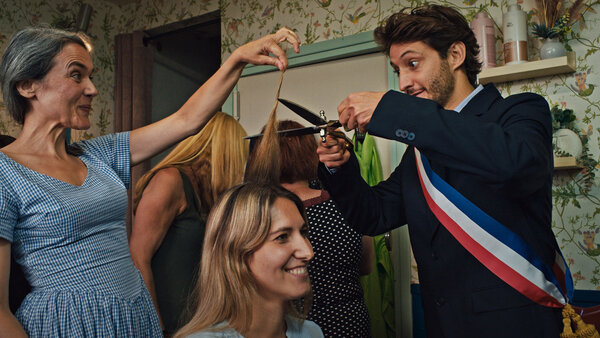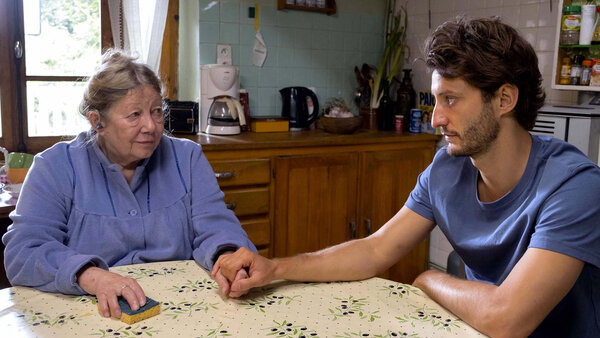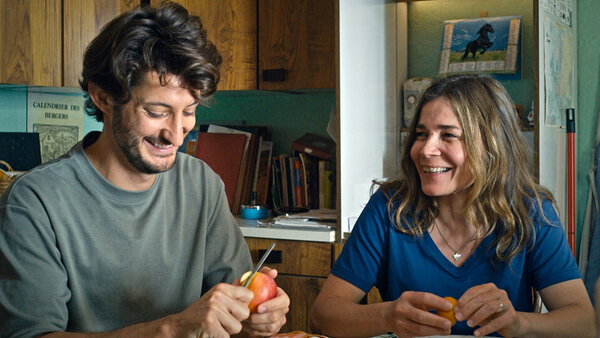Laurent Brunet, AFC, talks about his work with Michel Gondry on "The Book of solutions"
"The Marc Becker method", by François Reumont for the l’AFCMarc, a film director whose life and career are in turmoil, takes his film crew to a small village in the Cévennes, where his aunt Denise lives, to continue their shoot. There, Marc rediscovers his creativity and starts bursting with ideas. So many ideas in fact, that he decides to write the Book of Solutions, a book of advice.
You’ve been working with Michel Gondry since 2015... so would you say you’re a part of his "film family" ?
Laurent Brunet : I wouldn’t say I’m a part of his family exactly, but he calls me back to work on projects ! For several years now, Michel Gondry has been living and working mainly in Los Angeles. He recently shot there the series “Kidding” with Jim Carrey, as well as numerous commercials and clips. But when he comes back to France to make fiction films, he thinks of me. I think we get along well, and he trusts me... I understand what he wants, and I know how to adapt to his artisanal movie-making style.
What was the main challenge on "The Book of solutions" ?
LB : For this film, Michel absolutely wanted us to shoot where he grew up, in his aunt’s village (now deceased), in the heart of the Cévennes. He knew the house by heart : every step of the staircase, every pattern of the wood grain on the panelling... He is directly related to the story. Sometimes, he by thinking of past memories there, would come up with camera angles and would say things likes ’I stood exactly there’.
From that point of view, the atmosphere and working style was similar to both Microbe and Gasoil, – a film in which he also returned to his childhood, in search of his grandfather – and to his documentary L’épine dans le Cœur dedicated to his aunt (while she was still alive in 2010).

In the film, Pierre Niney’s character, Marc, is quite nasty with his team...
LB : Michel has a great sense of humour, especially about himself. Marc’s character in the film is proof of that. When you work with him, you have to take in his very diverse ideas, and above all, be proactive. He is not a patient or easy director, and as an operator, having the capacity to adapt quickly to all situations is essential. The directing always leads and the rest has to follow. For example, I had to shoot with very light equipment, sometimes with two cameras, while taking into account the fact that we would be in a small country house, with tiny rooms. And in that small space, having 4 or 5 actors at a time ! That was a real challenge for the lighting, as we couldn’t always light from the outside and Michel doesn’t like hanging lights, and often shot at 360° angles. He likes to work within these constraints, and as a director of photography I have to follow him. We made the film as we went along, finding the simplest solutions for each shot. That’s his trademark. And without ever tweaking anything !
Do you have an example ?
LB : The cooking films sequence with Aunt Denise (Françoise Lebrun) was shot directly with an old Hi8 video camera from the 1990s. We kept these exact images, no cheating. We kept what was made on the set. Even with the sequences shot with the RED camera, Michel insisted on keeping the rushes that I had produced on the set, hardly changing things after the edit, when we were colour timing. Every little slip, or thing that seemed slightly out of control in the flow of the action was kept.

What equipment did you choose in order to keep things light ?
LB : I chose to start with a RED Gemini, making it as compact as possible, in still camera mode. To do this, I moved everything I could into a backpack (battery, HF remote...) and only kept the camera body, without the matte-box, and fitted with Zeiss T2.1 lenses, which are very compact and that I know well. Lightness was the motto on this film. My team was composed of an assistant camera, an electrician and a grip, with additional when needed. The film was made over 35 days, with a really tight budget.
So was there a lot of on-the-shoulder filming ?
LB : Not necessarily. The idea was to have a camera set that was easy to move around with, and quick to set up. In the end, the film was really split between hand-held and steady shots. There were also some small camera moves, but I would say that the film was essentially made at arm’s length, with this very light camera, and few gripping constraints. For the ratio, Michel had initially mentioned shooting in 4:3, but finally we decided on the 1.5:1 ratio. It corresponds to 24x36, and it is usually in this format that he makes little animations with his smartphone. This deliberate choice was for me very humble, and characteristic of his filmmaking. Quite different from the wide format, which is a bit of a hassle.
The film was therefore framed, thought out, and edited according to this format. Unfortunately, at the end of post-production, production demanded that the film be reframed in 16:9 for distribution purposes, and that’s a pity. I’d always thought that cinema represented ultimate creative freedom... How could you ask Michel Gondry, such a singular creator, to paint only in blue ? Disappointments like these also happen to directors like him... And in the end, one is often forced to compromise.

What about the lighting ? Some of the effects are quite news-like...
LB : One of the lighting ideas Michel suggested to me during preparation was to start with scenes lit completely head-on, like the effect of a torch installed on a super-8 camera. With a strong vignetting because of the beam. I did some research and tested a lot of things that we would look at together. But this set-up was becoming too complicated to manage in the comical scenes. Although we did keep it in a few shots ; such as those of passing cars at night. All these shots were shot in one night, with a 4WD vehicle on which we installed a COB 600 on batteries in chase mode. Placed just behind the camera, it would light the frame in sync with the camera.
The orchestra sequence made everyone in the room laugh hysterically...
LB : Yes, that sequence is one of the funniest moments in the film. It’s actually based on a real moment that happened to Michel in the United States. A video had even been shot at the time, and he was quick to show it to us so that we could use it as inspiration. And it’s not the only funny example on this film !
I remember that sequence being a little stressful, because we had the whole orchestra in that small studio, with two cameras. That scene was shot in a day.
One of the sequences evokes film noir, with a shoot-out and a stunt !
LB : For that sequence, we had thought of using guns equipped with small LED bulbs that would flash to imitate gunshots. But there were technical problems, as the flashes were not strong enough. We shot with what we had, knowing that the scene was in the dark, in the attic room, where Vincent Elbaz was touching the ceiling with his head. We shot the whole film with small bulbs and Asteras, and there really wasn’t any space for anything else. We followed Michel’s energy, and the very specific vision he had. On this film, for example, he had already thought of each shot in detail. He had filled two notebooks with drawings of each scene he’d imagined. A medium that could be put aside at times, but which testified to his great experience on set and his great work capacities.
(Interview conducted by François Reumont and translated from French by Chloé Finch, for the AFC.)
The Book of solutions
Director : Michel Gondry
DoP : Laurent Brunet, AFC
Set Design : Pierre Pell
Costumes : Florence Fontaine
Sound : Guillaume Le Braz
Editing : Elise Fievet
 En
En Fr
Fr





